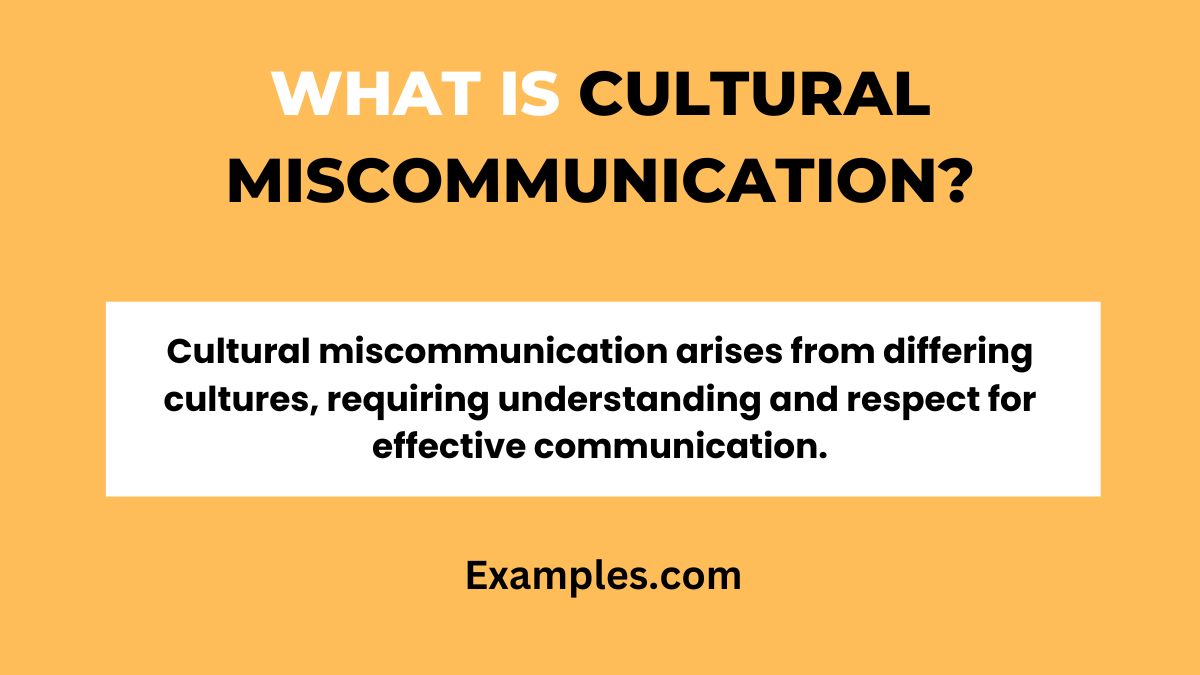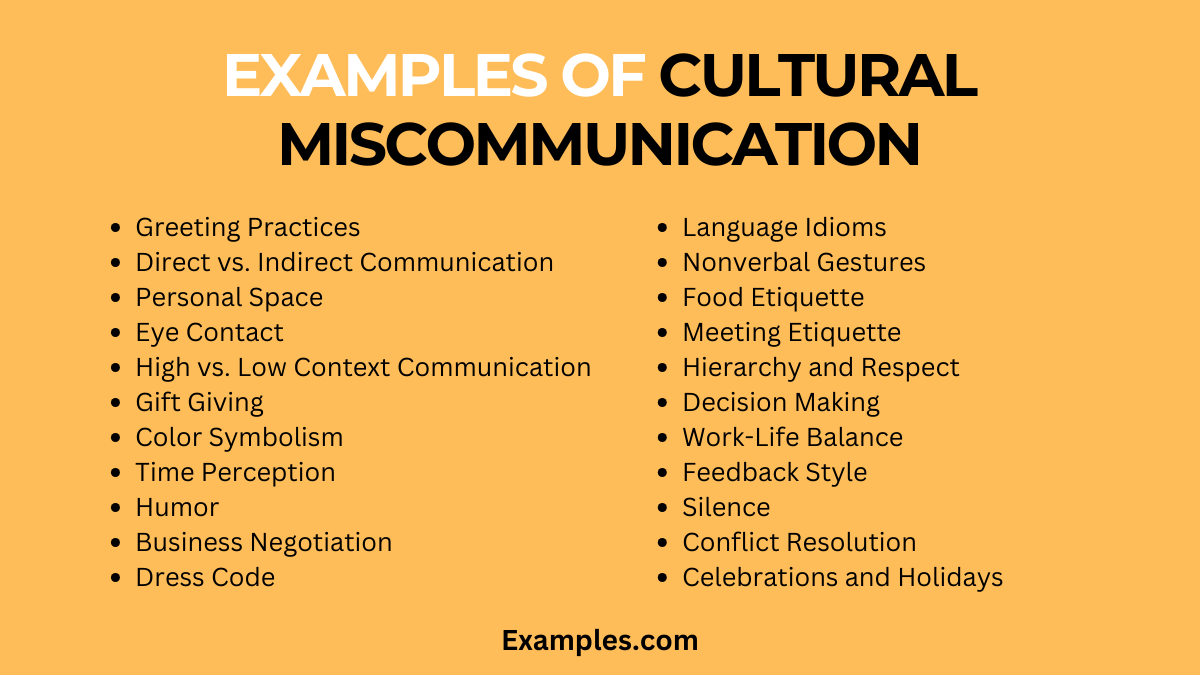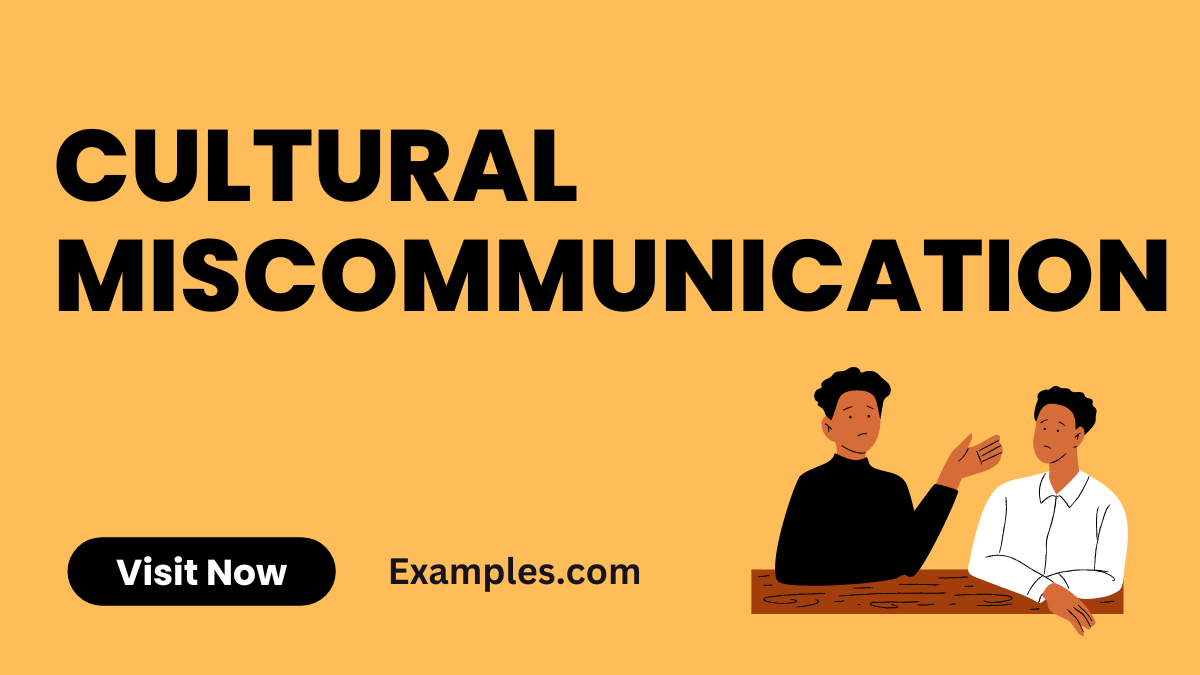Cultural Miscommunication
In a world brimming with cultural diversity, miscommunication can arise from differences in customs, language, and perspectives. This guide explores various miscommunication examples rooted in cultural nuances. By understanding these examples and their underlying causes, we can develop strategies to enhance our cross-cultural communication skills, fostering better understanding and cooperation in both personal and professional contexts.
What is Cultural Miscommunication?

Cultural miscommunication occurs when individuals from different cultural backgrounds misunderstand or misinterpret each other’s words, actions, or intentions. This often stems from differing cultural norms, values, or language expressions, leading to confusion and potential conflict. Understanding and respecting these differences is key to effective intercultural communication.
What is Best Example of Cultural Miscommunication?

One of the most striking examples of cultural miscommunication is when international businesses fail in local markets due to a lack of understanding of local customs and consumer behavior. A classic case is when a well-known American fast-food chain opened in India with a standard menu, not accounting for the cultural and religious dietary preferences that eschew beef. This oversight led to significant backlash and required a major strategy overhaul to align with local values and tastes.
15 Cultural Miscommunication Examples

Cultural miscommunication often arises from differing norms, values, and communication styles across cultures. It can lead to misunderstandings, discomfort, and even conflict. Recognizing and respecting cultural differences is key to effective global communication. This section explores 25 unique examples of cultural miscommunication, highlighting the importance of cultural awareness and sensitivity in our increasingly interconnected world.
- Greeting Gestures: In some cultures, a handshake is standard, while in others, it may be a bow or cheek kiss.
Communicate effectively: Research and respect greeting customs of other cultures. - Personal Space Norms: Proximity in conversations varies across cultures, leading to discomfort.
Communicate effectively: Be observant and adapt to the other person’s comfort level. - Eye Contact Differences: In some cultures, direct eye contact is respectful, in others, it’s seen as confrontational.
Communicate effectively: Understand and adapt to the eye contact norms of the culture. - Time Perception: Punctuality expectations differ, with some cultures viewing lateness as disrespectful.
Communicate effectively: Clarify time expectations in advance. - High vs. Low Context Communication: Misunderstandings arise when one culture prefers direct communication while another prefers indirect.
Communicate effectively: Be clear and explicit, especially in a multicultural context. - Gift Giving Customs: In some cultures, certain gifts may be considered inappropriate or unlucky.
Communicate effectively: Research gift customs to avoid unintended offense. - Dress Code Misinterpretations: Attire that is acceptable in one culture might be inappropriate in another.
Communicate effectively: Inquire about and observe dress codes in different cultural settings. - Humor Misunderstandings: Jokes that are funny in one culture might be offensive in another.
Communicate effectively: Be cautious with humor in cross-cultural interactions. - Decision-Making Styles: Cultures vary in their approach to decision-making, from collective to individualistic.
Communicate effectively: Respect and adapt to the decision-making norms of the culture. - Expressing Disagreement: Some cultures express disagreement openly, while others may avoid direct confrontation.
Communicate effectively: Be sensitive to how disagreement is expressed and received. - Silence Interpretation: Silence can be a sign of respect, thoughtfulness, or discomfort, depending on the culture.
Communicate effectively: Understand the meaning of silence in different cultural contexts. - Formality in Communication: Levels of formality in speech and writing vary widely among cultures.
Communicate effectively: Adapt your communication style to match the expected formality. - Food Etiquette: Eating habits and table manners differ, with specific cultural do’s and don’ts.
Communicate effectively: Observe and respect food etiquette of other cultures. - Workplace Hierarchies: Perceptions of hierarchy and authority vary, affecting communication in professional settings.
Communicate effectively: Be aware of and respect hierarchical dynamics in multicultural workplaces. - Emotional Expressiveness: The acceptability of showing emotions in public can vary greatly.
Communicate effectively: Be mindful of how emotions are expressed and interpreted across different cultures.
Types of Cultural Miscommunication

| Type | Description |
|---|---|
| Language Barriers | Misunderstandings arising from language differences, including vocabulary, idioms, and nuances. |
| Nonverbal Misinterpretations | Confusion caused by differing interpretations of body language, gestures, and facial expressions. |
| Contextual Differences | Misunderstandings due to differing cultural contexts, such as high-context (implicit) versus low-context (explicit) communication styles. |
| Normative Assumptions | Misinterpretations based on assumptions about ‘normal’ behavior, which may vary significantly across cultures. |
| Value Divergence | Conflicts arising from differing cultural values, such as individualism versus collectivism. |
Cultural Miscommunication in Business
- Negotiation Styles: Different cultures have unique approaches to negotiation, with some preferring directness and others valuing relationship-building. Misunderstanding these styles can lead to ineffective negotiations.
- Email Etiquette: The tone and formality in business emails can vary widely. A casual approach might be seen as unprofessional in some cultures, while a formal tone could be perceived as distant in others.
- Marketing Messages: Cultural nuances significantly impact marketing strategies. Misinterpreting cultural values can result in campaigns that fail to resonate or, worse, offend the target audience.
- Leadership Perceptions: Leadership styles acceptable in one culture might be ineffective or even inappropriate in another. Understanding cultural expectations of leadership is crucial for business success.
- Meeting Conduct: From punctuality to the structure of meetings, cultural differences can lead to misunderstandings. For instance, some cultures view starting a meeting with small talk as essential, while others may see it as a waste of time.
- Decision-Making Processes: In some cultures, decisions are made collectively, while in others, they are made by individuals in authority. Misunderstanding this aspect can cause friction and inefficiency.
- Contract Negotiations: The interpretation of contractual terms can vary. What is standard in one culture might be unacceptable in another, leading to difficult negotiations and potential legal issues.
- Building Trust: Different cultures have diverse ways of building and maintaining trust in business relationships. Misinterpreting these methods can hinder long-term business partnerships.
- Time Management: Perceptions of time urgency and deadlines differ among cultures. Failure to understand these differences can lead to missed deadlines and strained business relationships.
- Feedback and Critique: The manner of giving and receiving feedback is heavily influenced by cultural norms. Direct criticism that is normal in one culture might be seen as rude or disrespectful in another.
Cultural Miscommunication in the Workplace
- Work-Life Balance Expectations: Different cultural attitudes towards work-life balance can lead to misunderstandings. For example, the expectation of working late hours might be normal in some cultures but not in others.
- Team Collaboration Styles: Some cultures emphasize teamwork and collaboration, while others value individual contributions. Misinterpreting these preferences can impact team dynamics and productivity.
- Use of Language: Even in workplaces where a common language is spoken, nuances, idioms, and slang can lead to misunderstandings among employees from different cultural backgrounds.
- Hierarchy and Authority: Respect for hierarchy and authority varies across cultures. In some, questioning authority is common, while in others, it is frowned upon. Misunderstanding these norms can affect workplace harmony.
- Approach to Problem-Solving: Cultural differences in problem-solving can lead to misunderstandings. Some cultures might prefer a direct approach, while others might take a more roundabout route.
- Dress Code: Cultural interpretations of appropriate work attire can differ. What is considered professional in one culture might be too formal or casual in another.
- Body Language and Gestures: Nonverbal cues like hand gestures or eye contact can have different meanings in different cultures, potentially leading to miscommunications and discomfort.
- Socializing at Work: The expectation and nature of socializing in the workplace can differ culturally. Misunderstandings in this area can affect team cohesion and morale.
- Performance Evaluation: Cultural differences in giving and receiving performance feedback can lead to confusion and dissatisfaction among employees from diverse backgrounds.
- Resolving Conflicts: Approaches to conflict resolution vary by culture. In some, direct confrontation is preferred, while in others, indirect methods are more acceptable. Misunderstanding these approaches can exacerbate workplace conflicts.
Cultural miscommunication, often subtle yet impactful, can significantly hinder personal and professional relationships. This guide aims to illuminate these challenges, offering insights and practical tips to navigate the complexities of intercultural communication. By understanding and respecting diverse cultural norms and practices, we can foster more effective and harmonious interactions in our increasingly globalized world.



